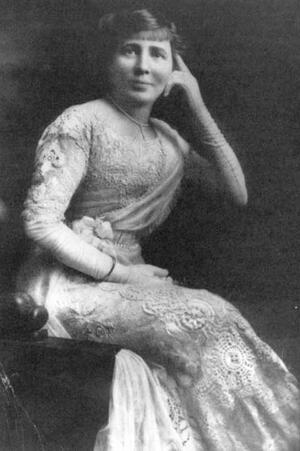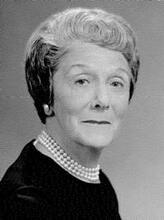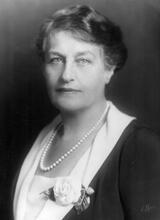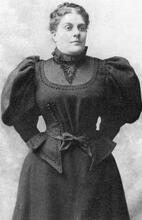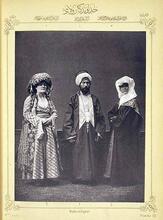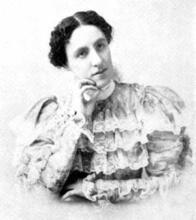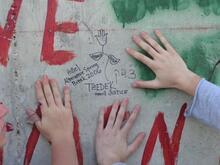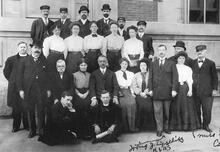Carrie Obendorfer Simon
Carrie Obendorfer Simon founded the Reform movement's National Federation of Temple Sisterhoods in 1913. Two years later, it had become the largest Jewish women's religious organization in the United States.
Institution: The Jacob Rader Marcus Center of the American Jewish Archives, Cincinnati, OH, www.americanjewisharchives.org
Carrie Obendorfer Simon began her career as a volunteer in her local chapter of the National Council of Jewish Women but became increasingly frustrated that the organization, challenged by rifts between Orthodox and Reform members, chose to avoid religious issues altogether. She therefore turned her attention to Temple Sisterhoods, becoming founding president of National Federation of Temple Sisterhoods from 1913 to 1919. During her presidency, she organized religious schools, increased synagogue attendance, and urged the Reform movement to include more women on synagogue boards and welcome intermarried couples. She also created a scholarship committee for rabbinical students and lay leaders. After her term ended, she remained active as honorary president and watched the organization grow to a membership of 100,000 globally.
Article
In an era in which Victorian social conventions limited most women to the private sphere of home and family, Carrie Obendorfer Simon broke important ground for American Jewish women by founding the National Federation of Temple Sisterhoods (NFTS) in the Union of American Hebrew Congregations (UAHC). Under her leadership, the federation expanded the scope of women’s social roles and offered new opportunities and rewarding experiences within the Reform Movement for those committed to Jewish and synagogue life.
Early Life
Carrie Obendorfer Simon was born on March 5, 1872, in Uniontown, Alabama, to Leo and Mary (Wise) Obendorfer. Within a few years of her birth, she moved with her family to Cincinnati, Ohio, where her father began a successful jewelry store and where Carrie graduated from the Cincinnati Conservatory of Music. While still a young woman, she became involved in a local chapter of the National Council of Jewish Women (NCJW), founded by her mother in 1895. Through its emphasis on self-education, public socializing, and charity work, the organization offered middle-class and upper-class German Jews like the Obendorfers an opportunity to enter the public arena without substantially challenging established gender roles.
On August 5, 1896, Carrie wed Abram Simon, whom she had met while he was a rabbinical student at Cincinnati’s Hebrew Union College (HUC). They had two sons, Leo and David. Following Abram’s graduation, he accepted a position in Sacramento, California, and the young couple moved out west. Between 1899 and 1904, Rabbi Simon served the Jewish community of Omaha, Nebraska, and in 1904 he was elected to the pulpit of the Washington (D.C.) Hebrew Congregation, where he remained until his death. As the wife of a rabbi, Carrie Simon took an increasingly active part in synagogue affairs and held a strong desire to enhance Jews’ devotion to their heritage. Because the NCJW had proved unable to unite its Orthodox and Reform elements and began instead to avoid religious issues, Simon focused her energies on strengthening temple sisterhoods.
Founding NFTS
With the support of Rabbi George Zepin, director of synagogue and school extension of the UAHC, Rabbi David Philipson, dean of American reform rabbis, and UAHC president Julius Walter Frieberg, Simon founded the National Federation of Temple Sisterhoods in January 1913 in order to promote Jewish social service and the home. The new body brought together chapters from around the country and doubled in size by 1915, thereby making NFTS the largest Jewish woman’s religious organization in the United States. As president of the federation from 1913 to 1919, Simon established the National Committee on Religion, which organized religious schools, increased synagogue attendance, and collected and displayed Jewish ceremonial objects. The Committee on Hebrew Union College Scholarships enabled young men of limited economic means to attend rabbinical school and raised funds for religious educational work by UAHC laypeople. Simon also used her position to encourage the UAHC to include more women on synagogue boards and to welcome intermarried couples into the temple and its sisterhood.
Philanthropy in Retirement
When her tenure as president ended in 1919, Simon continued as an active leader in the federation. She served as honorary president and spoke around the country on its behalf. In the early 1920s, she chaired a committee to raise funds for a student dormitory at HUC and devoted herself to the Jewish Braille Institute of America, founded in 1931, where sisterhood volunteers gave countless hours transcribing English, Yiddish, and Hebrew books for the blind. During her lifetime, Simon watched as NFTS grew from 5,000 members in 49 American chapters to a 100,000 women in 585 chapters throughout nine countries.
Carrie Obendorfer Simon died on March 3, 1961, in Washington, D.C.
AJYB 63: 562.
Marcus, Jacob R. The American Jewish Woman, 1654–1980 (1981), and The American Jewish Woman: A Documentary History (1981).
National Cyclopaedia of American Biography 28 (1940): 54, s.v. “Abram Simon”.
Nadell, Pamela S., and Rita J. Simon. “Ladies of the Sisterhood: Women in the American Reform Synagogue, 1900–1930.” In Active Voices: Women in Jewish Culture, edited by Maurie Sacks (1985).
Obituary. NYTimes, March 4, 1961, 23:5.
Rogow, Faith. Gone to Another Meeting: The National Council of Jewish Women, 1893–1993 (1993).
Umansky, Ellen M. “Carrie Obendorfer Simon.” In Reform Judaism in America: A Biographical Dictionary and Sourcebook, edited by Kerry M. Olitzky, Lance J. Sussman, and Malcolm H. Stern (1993).
UJE.
Washington Post, March 4, 1961, C3.
WWIAJ, 1926.

